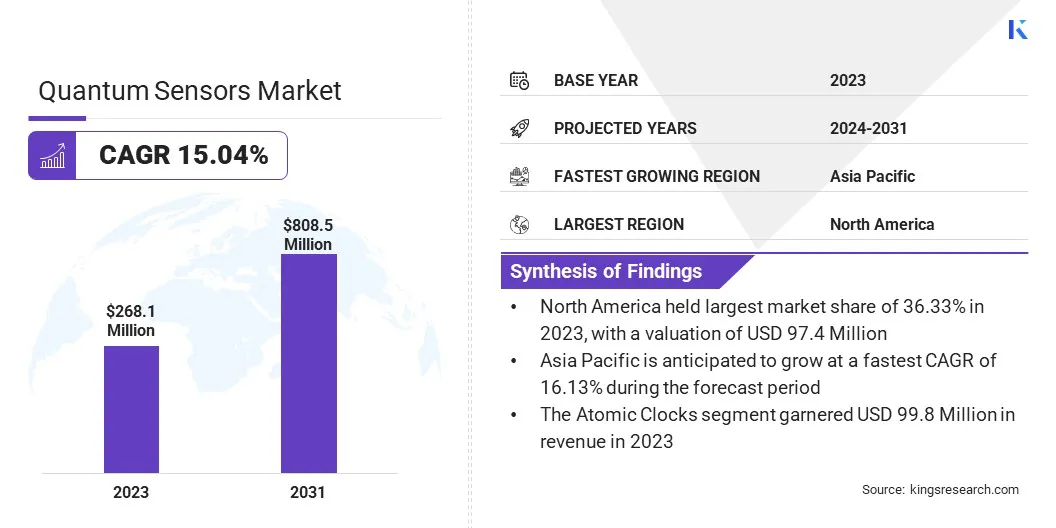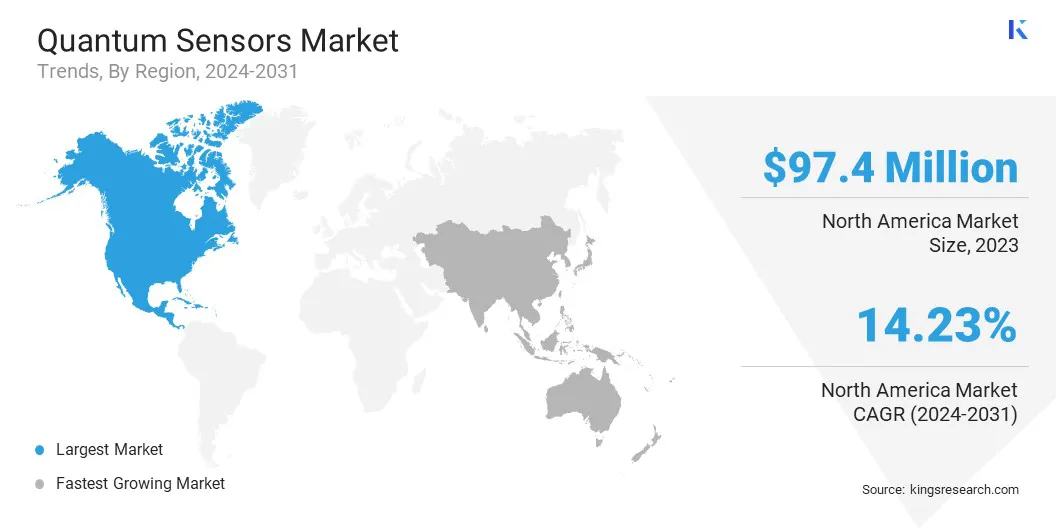Market Definition
The market encompasses technologies that utilize quantum phenomena such as superposition, entanglement, and quantum tunneling to achieve highly sensitive and accurate measurements.
These sensors are used across various applications including navigation, medical imaging, geophysical exploration, and defense as they offers superior performance over traditional sensing technologies. The report provides a comprehensive analysis of key drivers, emerging trends, and the competitive landscape expected to influence the market over the forecast period.
Quantum Sensors Market Overview
The global quantum sensors market size was valued at USD 268.1 million in 2023 and is projected to grow from USD 303.2 million in 2024 to USD 808.5 million by 2031, exhibiting a CAGR of 15.04% during the forecast period.
The growing applications of quantum sensors in healthcare and medical imaging, driven by their high sensitivity and non-invasive nature, alongside advancements in miniaturization and integration, are enhancing device performance and expanding their use across clinical and research settings.
Major companies operating in the quantum sensors industry are Campbell Scientific, Inc., ID Quantique, LI-COR, Inc., M Squared Lasers Limited, Muquans, AOSense, Inc., Atomionics Pte Ltd, Apogee Instruments, Inc., QuantumDiamonds, Q-CTRL, Nomad Atomics, Skye Instruments Ltd, SICK AG, KWAN-TEK and others.
The market is driven by the increasing need for ultra-precise measurement tools across industries such as defense, aerospace, and geophysics. Quantum sensors offer significantly higher sensitivity and accuracy compared to classical sensors, enabling precise detection of gravitational fields, magnetic variations, and inertial movements.
This is essential for critical applications such as submarine navigation, underground resource detection, and satellite-based earth observation.
- In April 2025, NASA announced the development of the Quantum Gravity Gradiometer Pathfinder, the first space-based quantum sensor for gravity measurements. This initiative aims to meet the growing demand for ultra-sensitive and compact sensing technologies, enabling advanced applications in resource mapping, planetary science, and Earth observation.

Key Highlights:
- The quantum sensors market size was recorded at USD 268.1 million in 2023.
- The market is projected to grow at a CAGR of 15.04% from 2024 to 2031.
- North America held a market share of 36.33% in 2023, with a valuation of USD 97.4 million.
- The atomic clocks technology segment garnered USD 99.8 million in revenue in 2023.
- The healthcare segment is expected to reach USD 244.3 million by 2031.
- Asia Pacific is anticipated to grow at a CAGR of 16.13% during the forecast period.
Market Driver
Growing Applications in Healthcare and Medical Imaging
The quantum sensors market is influenced by the growing use of quantum sensors in healthcare and medical imaging due to their ultra-sensitive and non-invasive diagnostic capabilities.
Nitrogen-vacancy (NV) center-based sensors enable high-resolution magnetic field detection, supporting advancements in brain imaging, early disease detection, and improved MRI performance. This integration drives demand in biomedical research and clinical diagnostics, contributing to market growth.
In April 2025, Bosch, in partnership with Element Six, launched Bosch Quantum Sensing to commercialize compact quantum magnetic field sensors built with synthetic diamonds. The initiative aims to address the rising demand for high-precision sensing solutions across healthcare, navigation, and resource exploration sectors.
Market Challenge
Technical Challenges in Quantum Sensor Development
Quantum sensors are highly sensitive to environmental factors such as temperature fluctuations, electromagnetic interference, and mechanical vibrations, which can drastically affect their accuracy and reliability, making their integration into practical, real-world applications particularly challenging.
To address these challenges, companies are developing advanced shielding, vibration isolation, and thermal stabilization techniques. Innovations like cryogenic cooling and housing sensors in controlled environments are also being explored to improve sensor precision and make them more suitable for practical applications.
Market Trend
Miniaturization and Integration of Quantum Sensors
The miniaturization of quantum sensors is a key trend in the industry, with advancements enabling more compact and integrated devices. Technologies such as nitrogen-vacancy (NV) centers and nuclear quadrupolar resonance (NQR) are leading the way in reducing the size of sensors without compromising their precision.
This trend is enhancing the deployment of quantum sensors in sectors like healthcare, defense, and scientific research, offering new possibilities for innovation and precision.
- In January 2025, Penn Engineering introduced a new quantum sensing method that combines nuclear quadrupolar resonance with nitrogen-vacancy centers in diamonds. This approach allows for the detection of atomic-level signals and meets the growing need for precise molecular analysis in areas such as drug development and protein research.
Quantum Sensors Market Report Snapshot
|
Segmentation
|
Details
|
|
By Product Type
|
Atomic Clocks, Magnetic Sensors, Photosynthetically Active Radiation (PAR) Sensors, Others
|
|
By End-Use Industry
|
Military and Defense, Healthcare, Automotive, Aerospace, Others
|
|
By Region
|
North America: U.S., Canada, Mexico
|
|
Europe: France, UK, Spain, Germany, Italy, Russia, Rest of Europe
|
|
Asia-Pacific: China, Japan, India, Australia, ASEAN, South Korea, Rest of Asia-Pacific
|
|
Middle East & Africa: Turkey, U.A.E., Saudi Arabia, South Africa, Rest of Middle East & Africa
|
|
South America: Brazil, Argentina, Rest of South America
|
Market Segmentation:
- By Product Type (Atomic Clocks, Magnetic Sensors, Photosynthetically Active Radiation (PAR) Sensors, Others): The atomic clocks segment earned USD 99.8 million in 2023 due to their high precision and growing demand in defense, aerospace, and telecommunications applications.
- By End-use Industry (Military and Defense, Healthcare, Automotive, and Aerospace, Others): The military and defense segment held 33.96% of the market in 2023, due to increased adoption of quantum sensors for navigation, surveillance, and secure communication systems.
Quantum Sensors Market Regional Analysis
Based on region, the global market has been classified into North America, Europe, Asia Pacific, Middle East & Africa, and South America.

North America quantum sensors market share stood around 36.33% in 2023 in the global market, with a valuation of USD 97.4 million. This dominance is attributed to strong government support and a well-established research ecosystem.
Initiatives such as the U.S. National Quantum Initiative, along with substantial investments from defense and space agencies such as DARPA and NASA, are accelerating advancements in quantum sensing technologies. In addition, collaborative efforts between academic institutions and industry players are speeding up technological development and commercialization across the region.
The Asia-Pacific quantum sensors industry region is poised for significant growth at a robust CAGR of 16.13% over the forecast period, driven by the rising demand for advanced technologies and the growing industrial and consumer needs.
Industries in sectors such as healthcare, defense, manufacturing, and smart cities are increasingly adopting quantum sensors for their precision and efficiency. Additionally, the expanding consumer electronics and health monitoring market further accelerates the demand for highly sensitive and accurate quantum sensor systems.
- In July 2024, Forschungszentrum Jülich and Korea's IBS Center for Quantum Nanoscience developed a quantum sensor capable of detecting magnetic fields at the atomic scale. The innovation provides high-precision tools for studying quantum materials and performing atomic-level measurements. It is also expected to improve MRI sensitivity and accuracy, enabling better diagnostic capabilities in medical imaging.
Regulatory Frameworks
- In the U.S., the market is regulated by the National Quantum Initiative Act (NQI), which sets a strategic framework for the development, standardization, and commercialization of quantum technologies.
- Europe has established the Low Voltage Directive (LVD) – 2014/35/EU, which sets safety and performance standards for electrical equipment operating within specific voltage ranges, including quantum sensors.
Competitive Landscape
Companies in the quantum sensors market are actively engaging in strategic initiatives to strengthen their technological edge and expand their market footprint. Key players are forming research collaborations with academic institutions and government bodies to accelerate innovation in areas such as sensor precision, miniaturization, and system integration.
In addition to collaborative efforts, companies are investing in advanced manufacturing capabilities and dedicated quantum research facilities to support product development and commercialization.
- In August 2024, QuantumDiamonds partnered with the Fraunhofer Institute for Electromagnetic Field Theory to develop a high-resolution quantum sensing microscope. The collaboration targets the rising need for precise semiconductor analysis and supports the advancement of quantum sensor technology for broader use in research and industrial applications.
List of Key Companies in Quantum Sensors Market:
- Campbell Scientific, Inc.
- ID Quantique
- LI-COR, Inc.
- M Squared Lasers Limited
- Muquans
- AOSense, Inc.
- Atomionics Pte Ltd
- Apogee Instruments, Inc.
- QuantumDiamonds
- Q-CTRL.
- Nomad Atomics
- Skye Instruments Ltd
- SICK AG
- KWAN-TEK
Recent Developments (New Product Launches)
- In March 2025, Fermilab finalized a partnership with Diraq and University of Wisconsin–Madison for the Quandarum project, aiming to develop a quantum sensor by combining silicon spin qubits and cryogenic skipper readout technology. Supported by the DOE’s QuantISED program, the project focuses on enabling scientists to detect faint signals from the cosmos, with potential applications in studying dark matter.
- In April 2025, Q-CTRL announced successful trials of its quantum-assured navigation system, which uses advanced quantum sensors to deliver stealthy, jam-proof GPS-free positioning.
- In February 2025, DARPA launched the Robust Quantum Sensors (RoQS) program to advance the deployment of quantum sensors in real-world defense applications. It aims to overcome challenges such as vibrations and electromagnetic interference by developing highly precise and resilient sensors suitable for integration into defense platforms.
- In September 2024, KWAN-TEK and HIQUTE DIAMOND formed a strategic partnership to enhance quantum metrology solutions. This collaboration combines HIQUTE's expertise in quantum-grade diamond materials with KWAN-TEK's capabilities in sensor integration, boosting Europe's diamond-based quantum sensing ecosystem.
and others


